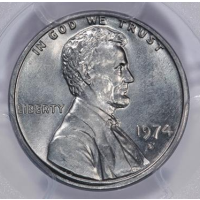The Strange Case of the Aluminum Penny
 (photo: Professional Coin Grading Service)
(photo: Professional Coin Grading Service)
Two California men seeking to auction a rare aluminum penny have been told by the federal government to stop, resulting in a lawsuit against the Department of the Treasury and the United States Mint.
The story begins with Randall Lawrence, a real estate agent who possessed the penny for years without realizing its value until after he sold it, along with other coins, to Michael McConnell, owner of the La Jolla Coin Shop of San Diego.
McConnell informed Lawrence that the penny, made in 1974 at the Denver Mint, was part of a rare batch made of aluminum, instead of the traditional copper. The coin collector estimated the penny could be worth $250,000, and the two men agreed to auction it off. They plan to donate up to $100,000 of the proceeds to local homeless programs and split the rest between them.
The government briefly considered switching to aluminum due to a spike in copper prices during the previous year. In 1973, Chile’s democratically-elected president, Salvador Allende, nationalized U.S. copper mines, which helped set off a crisis that not only impacted the price of copper but also resulted in Allende being overthrown in a military coup backed by the Central Intelligence Agency (CIA) under President Richard Nixon.
Mint officials ultimately decided to scrap the idea of making pennies out of aluminum, although not before 1.5 million of the coins were produced.
The aluminum pennies were never issued, and most were destroyed. A few were given to members of Congress.
Lawrence says the penny belonged to his father, Harry Lawrence, who worked as deputy superintendent at the Denver Mint for 20 years, including the year the coin was struck. The younger Lawrence found it among his father’s belongings after his death in 1980.
“When he died . . . that coin and others he received over the years were in a plastic sandwich bag,” recalled Lawrence, according to CoinNews.net. “I kept them in that bag in my desk for 33 years. . . . I had no idea what that penny was worth.”
McConnell initially thought the penny was a low-value foreign souvenir coin. He discovered its real value sometime after purchasing the collection from Lawrence. He got back in touch with him to disclose what he had learned. “I wouldn’t [have been] able to sleep without notifying him," McConnell said.
“It’s a godsend,” Lawrence told U-T San Diego. “For someone so honest to come back to me and want to share this with me really got me to the core.”
Regardless of how Lawrence came to possess the coin, the Treasury Department contends it’s not his to sell.
Because the aluminum pennies were never officially issued, the department claims that all such coins are still government property and should be returned.
Lawrence rejects this notion.
“Thousands of coins minted by or for the U.S. Mint that were never ‘issued’ as legal tender have been widely and publicly collected and purchased and sold by coin collectors and dealers for over a century without any claims whatsoever from the government,” he contends in the lawsuit, filed in U.S. District Court for the Southern District of California. “These include coins that were actually sold or ‘gifted’ by the Mint itself such as the aluminum cents, as well as coins that left the Mint under unknown circumstances.”
Lawrence has called the government’s position “radical,” and asked a federal judge to invalidate the Treasury Department’s claim to the penny.
Meanwhile, Heritage Auctions plans to sell the penny for Lawrence and McConnell at a coin convention in April.
–Noel Brinkerhoff, Danny Biederman
To Learn More:
Collector Says Uncle Sam Has No Right to His Rare 1974 Aluminum Penny (by Elizabeth Warmerdam, Courthouse News Service)
1974 Aluminum Lincoln Cent from Denver Mint Authenticated, at Long Beach (by Darrin Lee Unser, CoinNews)
A Penny Saved Could Net Pair $250,000 (by Pam Kragen, U-T San Diego)
Aluminum Cent’s Fate in Doubt (by Dave Harper, SilverCoins)
- Top Stories
- Controversies
- Where is the Money Going?
- California and the Nation
- Appointments and Resignations
- Unusual News
- Latest News
- California Forbids U.S. Immigration Agents from Pretending to be Police
- California Lawmakers Urged to Strip “Self-Dealing” Tax Board of Its Duties
- Big Oil’s Grip on California
- Santa Cruz Police See Homeland Security Betrayal in Use of Gang Roundup as Cover for Immigration Raid
- Oil Companies Face Deadline to Stop Polluting California Groundwater





